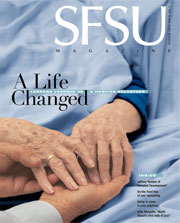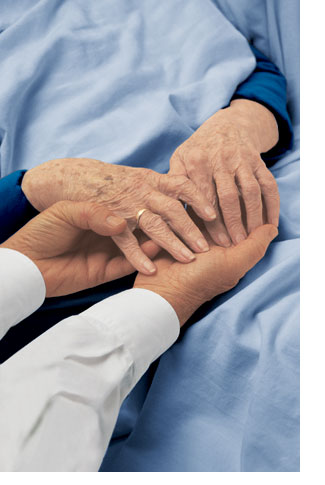 |
| |||
 A Life Changed A Life ChangedLessons learned as a hospice volunteer Professor Stanley Goldberg shares in the lives of people during their final weeks, days and hours. These individuals, he says, have taught him how to live. "We're going to ask you to fall in love with people who'll leave you within months or even weeks. Then we're going to ask you to do it again and again." It was the first day of my volunteer training session at the Zen Hospice Project. The sessions were run by its founder, Frank Ostaseski, who has devoted his life to serving the dying and to training people similarly committed to their care. It was an unnerving concept. How would it be possible to allow myself to fall in love with someone, knowing with certainty that they would be leaving me within a very short time? Before I had a chance to come to terms with his first statement, Frank uttered a second and more difficult one: "There's a distinction between fixing, helping and serving. "In my mind, I didn't see any difference. I viewed all three as identical. As a speech-language pathologist, I thought I had been doing these three things simultaneously for the past 25 years. "When you fix, you assume something is broken," Fred said. "When you help, you see the person as weak. But when you serve, you see the person as intrinsically whole. You create a relationship in which both parties gain. The purpose of hospice is to serve." I realized that for my entire professional career I was a fixer and helper. Someone who could look at a problem that a child had and either find a solution or minimize its effects. I now was being asked to place a defining characteristic of my identify on a shelf and assume a new role, a server. Instead of continuing to explain with words, Frank pulled out a stack of 100 black-and-white photographs of people who had died in hospice during the past year. "I'd like you to look at each one intently before passing them to the person on your right. Everyone here has died, but imagine that they're still alive. Just think about your reactions to what you're seeing. Then we'll talk." As we looked at the beautiful photographs of people who were in the process of dying, my first reaction was to do everything in my power to help them. At about the 50th photograph, I realized there was nothing here to fix. Everyone would still die in spite of my efforts, in spite of anyone's efforts. I was beginning to have a theoretical understanding of service. But I've come to believe that theory is the lowest level of understanding. The next up involves the concept's application. I didn't have to wait long for that to happen. It occurred during my first week as a volunteer. "There are so many of you," she wrote on the small erasable slate outlined with yellow plastic flowers. "I know," I said. "We multiply like bunnies." Cindy was referring to the number of volunteers at the Guest House, a restored Victorian home in San Francisco for residents who were not expected to live for more than six months. She tried to laugh, but only the right side of her face and lips moved in a slight upward direction. The surgeon had removed her cancerous pharynx and tongue, and created a stoma, an opening in the front of her throat to breathe. Unfortunately, the tumor had spread rapidly and surrounded the carotid artery. Cindy's prognosis was poor. For two years, Anna, her mother, was with her constantly, taking care of every need. As her condition worsened, Anna could no longer care for her 57-year-old daughter in their one-bedroom apartment. They came to the Guest House to spend the last weeks together. During the first two weeks, Cindy was still alert enough to communicate by using her slate and gestures. Often a look was sufficient. A movement of her head toward Anna meant she would like to talk with me without her mother present. "Anna, why don't you take a break?" I suggested. "You can have a nice cup of tea downstairs. Cindy and I will be fine together." "Are you sure?" Anna asked, looking anxiously toward her daughter. Cindy gestured toward her mother, as if shooing a child out of a room. She left and Cindy shook her head. "Lonely when I'm gone," she wrote. "I know," I said. "We're all doing whatever we can to prepare her. I think the social worker is trying to find a support group when you leave." She shook her head again and laid it back on her pillow. Cindy was meticulous about her appearance even as she approached death. When I came the following week for my Thursday shift, I learned she had refused to take any more nourishment or water. In hospice, the wishes of the residents are paramount, whether it involves something we think is trivial, such as the placement of flowers in their room, or something as serious as refusing food. For the volunteers and staff it was irrelevant why she chose not to receive nutrients. Choices are respected. During her stay at the Guest House, when clothes or bed linens needed to be changed, Cindy would allow only female volunteers present. However, there came a time when there were no female volunteers on my shift and the attendant asked for my assistance in changing Cindy. "It's OK, Cindy. Don't be embarrassed, look who it is," Anna kept repeating. We had become friends and confidants over the past few weeks. Most of our conversations involved gestures and nods. Neither of us was embarrassed the first time I helped in cleaning Cindy's body. It was just another thing we did together. During the last week of her life, the bedsores on Cindy's back became extremely painful. When changing her shirt, I supported her as she sat on the edge of the bed. Afterward, she refused to lie back down. Squeezing my hand firmly, Cindy indicated with her head that she wanted to continue sitting. I decided to sit close so my entire arm could support her. "Is that OK?" I asked. She slowly nodded her head with her eyes closed. I thought it would be fine, but I never assume anything with residents. Each is unique in his or her needs. There is no such thing as uniformity in dying. What pleases one resident angers or causes pain to another. As I held Cindy, I noticed she began leaning on me. As I felt my right side support her entire body, the words and music of Bill Withers' song "Lean on Me" formed in my mind.
As I cradled her body with my right arm, her tension began to diminish. As it did, her grip also changed. It became soft and almost caressing. Occasionally, Cindy would release her grip and move her fingers lovingly over mine. As I sat with her, I didn't see a person whose body was ravaged by cancer. I felt I was in the presence of a complete individual who graciously was allowing me to share a profound experience. She was letting go of everything and relying on my presence to get her through intense physical pain and the uncertainty of the journey she would soon begin. When I try to explain to people that each day I leave the Guest House I feel I've received more than I've given, most people think I'm being unduly modest. "It's a mitzvah (blessing) what you do," my Jewish friend would say. "We're very proud of you," my family repeatedly tells me. "You've been a blessing to us," families of the dying say through tears. Most people who don't do it view serving as a sacrifice -- something altruistic and totally giving. Nothing could be further from the truth. Few understand that serving someone as they approach death is incredibly rewarding. It's like having an endless supply of water being poured into a small bucket. There is no way it can contain the cascade. When I sat with Cindy the next week, she would occasionally open her eyes and make hand movements. Before I left, I kissed her on the forehead, saying goodbye for what I knew was the last time. "I'm going to miss you very much. You've meant a lot to me and everyone else in the house. Thank you for what you've taught me. I love you and we'll watch over Anna. Have a good journey." Two days after I saw Cindy, all of the volunteers received an e-mail: "Cindy died peacefully this morning, pronounced at 8:15 a.m. Anna was at her side when she took her last breath. We surrounded her with candles and the flowers from her room. Thanks again for all the support and love you have given Cindy and Anna." Serving gives purpose to life. Yes, it benefits others. But it's unique among all other human activities in what it does to those who practice it. In spite of what you give, you receive significantly more. I helped Cindy in the dying process, but in return, without asking, she taught me the importance of letting go. Being involved in her death brought me to that third level of understanding. Every resident I've served has been my teacher. Lessons are never requested. They just occur. If I listen carefully, I receive them. Metaphorically, they say: "Listen, this is important." Often they have the subtlety of a sledgehammer. Others I'm still struggling to understand. But all move me forward in my understanding of life. For many people, these lessons are rare occurrences. For those involved in service, they happen every day. I remember a question I asked Frank shortly after I began at the Guest House: "How do you know what's the right thing to say or do? With my clients, if I say something wrong or even stupid, I know I can fix it next week. But with the dying, there may not be a next week." Without any hesitation he said, "You've been doing these things your entire life. Not just as a therapist, but as a human being. If you're present, you'll know the right thing to do." He was right. In hospice we hope our service leads to a peaceful and dignified death for residents. Sometimes it does; other times it doesn't. You always grow regardless of the outcome. I recently visited my daughter in New York City. As we walked through Greenwich Village on a cold winter day, we came upon a wonderful scene painted by children on a wall, which included a quote by a well-known educator:
As I stood there and reviewed what I have gained by serving the dying and how it has given purpose to my life and changed me, I realized that I'm not paying enough rent. More about Professor Goldberg. Abridged essay used with permission from The Power of Purpose Essay Awards sponsored by the John Templeton Foundation. To read Professor Goldberg's essay in its entirety, please visit: www.powerofpurpose.org | ||||









